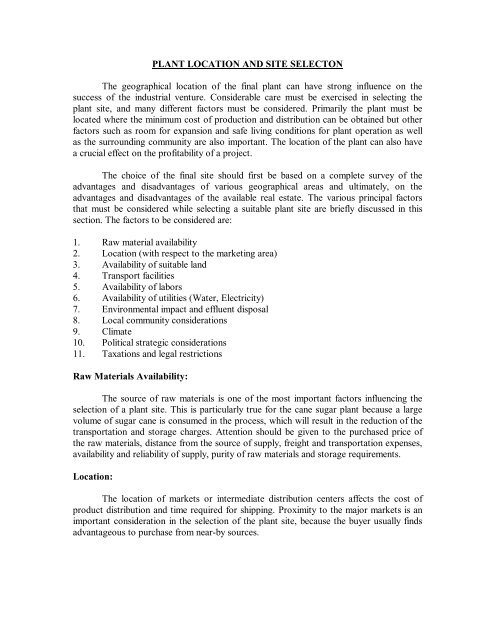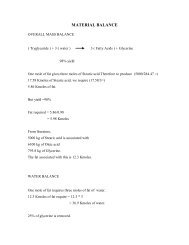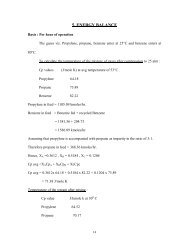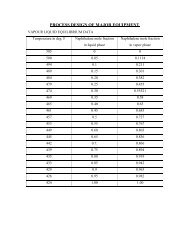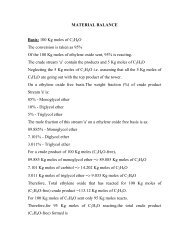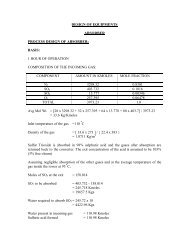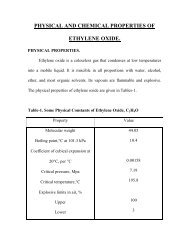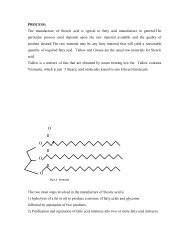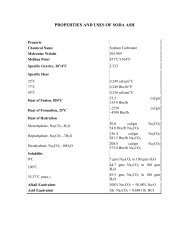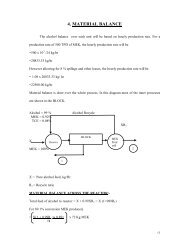Plant Location&Layout
Plant Location&Layout
Plant Location&Layout
Create successful ePaper yourself
Turn your PDF publications into a flip-book with our unique Google optimized e-Paper software.
PLANT LOCATION AND SITE SELECTON<br />
The geographical location of the final plant can have strong influence on the<br />
success of the industrial venture. Considerable care must be exercised in selecting the<br />
plant site, and many different factors must be considered. Primarily the plant must be<br />
located where the minimum cost of production and distribution can be obtained but other<br />
factors such as room for expansion and safe living conditions for plant operation as well<br />
as the surrounding community are also important. The location of the plant can also have<br />
a crucial effect on the profitability of a project.<br />
The choice of the final site should first be based on a complete survey of the<br />
advantages and disadvantages of various geographical areas and ultimately, on the<br />
advantages and disadvantages of the available real estate. The various principal factors<br />
that must be considered while selecting a suitable plant site are briefly discussed in this<br />
section. The factors to be considered are:<br />
1. Raw material availability<br />
2. Location (with respect to the marketing area)<br />
3. Availability of suitable land<br />
4. Transport facilities<br />
5. Availability of labors<br />
6. Availability of utilities (Water, Electricity)<br />
7. Environmental impact and effluent disposal<br />
8. Local community considerations<br />
9. Climate<br />
10. Political strategic considerations<br />
11. Taxations and legal restrictions<br />
Raw Materials Availability:<br />
The source of raw materials is one of the most important factors influencing the<br />
selection of a plant site. This is particularly true for the cane sugar plant because a large<br />
volume of sugar cane is consumed in the process, which will result in the reduction of the<br />
transportation and storage charges. Attention should be given to the purchased price of<br />
the raw materials, distance from the source of supply, freight and transportation expenses,<br />
availability and reliability of supply, purity of raw materials and storage requirements.<br />
Location:<br />
The location of markets or intermediate distribution centers affects the cost of<br />
product distribution and time required for shipping. Proximity to the major markets is an<br />
important consideration in the selection of the plant site, because the buyer usually finds<br />
advantageous to purchase from near-by sources.
Availability Of Suitable Land:<br />
The characteristics of the land at the proposed plant site should be examined<br />
carefully. The topography of the tract of land structure must be considered, since either or<br />
both may have a pronounced effect on the construction costs. The cost of the land is<br />
important, as well as local building costs and living conditions. Future changes may make<br />
it desirable or necessary to expand the plant facilities. The land should be ideally flat,<br />
well drained and have load-bearing characteristics. A full site evaluation should be made<br />
to determine the need for piling or other special foundations<br />
Transport:<br />
The transport of materials and products to and from plant will be an overriding<br />
consideration in site selection. If practicable, a site should be selected so that it is close to<br />
at least two major forms of transport: road, rail, waterway or a seaport. Road transport is<br />
being increasingly used, and is suitable for local distribution from a central warehouse.<br />
Rail transport will be cheaper for the long-distance transport. If possible the plant site<br />
should have access to all three types of transportation. There is usually need for<br />
convenient rail and air transportation facilities between the plant and the main company<br />
head quarters, and the effective transportation facilities for the plant personnel are<br />
necessary.<br />
Availability Of Labors:<br />
Labors will be needed for construction of the plant and its operation. Skilled<br />
construction workers will usually be brought in from outside the site, but there should be<br />
an adequate pool of unskilled labors available locally; and labors suitable for training to<br />
operate the plant. Skilled tradesmen will be needed for plant maintenance. Local trade<br />
union customs and restrictive practices will have to be considered when assessing the<br />
availability and suitability of the labors for recruitment and training.<br />
Availability Of Utilities:<br />
The word “utilities” is generally used for the ancillary services needed in the<br />
operation of any production process. These services will normally be supplied from a<br />
central facility and includes Water, Fuel and Electricity which are briefly described as<br />
follows:<br />
Water: - The water is required for large industrial as well as general purposes, starting<br />
with water for cooling, washing and steam generation. The plant therefore must be<br />
located where a dependable water supply is available namely lakes, rivers, wells, seas. If<br />
the water supply shows seasonal fluctuations, it’s desirable to construct a reservoir or to<br />
drill several standby wells. The temperature, mineral content, slit and sand content,<br />
bacteriological content, and cost for supply and purification treatment must also be<br />
considered when choosing a water supply. De-mineralized water, from which all the<br />
minerals have been removed, is used where pure water is needed for the process use, in
oiler feed. Natural and forced draft cooling towers are generally used to provide the<br />
cooling water required on site.<br />
Electricity: - Power and steam requirements are high in most industrial plants and fuel is<br />
ordinarily required to supply these utilities. Power, fuel and steam are required for<br />
running the various equipments like generators, motors, turbines, plant lightings and<br />
general use and thus be considered, as one major factor is choice of plant site.<br />
Environmental Impact And Effluent Disposal:<br />
Facilities must be provided for the effective disposal of the effluent without any<br />
public nuisance. In choosing a plant site, the permissible tolerance levels for various<br />
effluents should be considered and attention should be given to potential requirements for<br />
additional waste treatment facilities. As all industrial processes produce waste products,<br />
full consideration must be given to the difficulties and coat of their disposal. The disposal<br />
of toxic and harmful effluents will be covered by local regulations, and the appropriate<br />
authorities must be consulted during the initial site survey to determine the standards that<br />
must be met.<br />
Local Community Considerations:<br />
The proposed plant must fit in with and be acceptable to the local community. Full<br />
consideration must be given to the safe location of the plant so that it does not impose a<br />
significant additional risk to the community.<br />
Climate:<br />
Adverse climatic conditions at site will increase costs. Extremes of low<br />
temperatures will require the provision of additional insulation and special heating for<br />
equipment and piping. Similarly, excessive humidity and hot temperatures pose serious<br />
problems and must be considered for selecting a site for the plant. Stronger structures will<br />
be needed at locations subject to high wind loads or earthquakes.<br />
Political And Strategic Considerations:<br />
Capital grants, tax concessions, and other inducements are often given by<br />
governments to direct new investment to preferred locations; such as areas of high<br />
unemployment. The availability of such grants can be the overriding consideration in site<br />
selection.<br />
Taxation And Legal Restrictions:<br />
State and local tax rates on property income, unemployment insurance, and<br />
similar items vary from one location to another. Similarly, local regulations on zoning,<br />
building codes, nuisance aspects and others facilities can have a major influence on the<br />
final choice of the plant site.
PLANT LAY OUT<br />
After the flow process diagrams are completed and before detailed piping,<br />
structural and electrical design can begin, the layout of process units in a plant and the<br />
equipment within these process unit must be planned. This layout can play an important<br />
part in determining construction and manufacturing costs, and thus must be planned<br />
carefully with attention being given to future problems that may arise.<br />
Thus the economic construction and efficient operation of a process unit will<br />
depend on how well the plant and equipment specified on the process flow sheet is laid<br />
out. The principal factors that are considered are listed below:<br />
1. Economic considerations: construction and operating costs<br />
2. Process requirements<br />
3. Convenience of operation<br />
4. Convenience of maintenance<br />
5. Health and Safety considerations<br />
6. Future plant expansion<br />
7. Modular construction<br />
8. Waste disposal requirements<br />
Costs:<br />
Adopting a layout that gives the shortest run of connecting pipe between<br />
equipment, and least amount of structural steel work can minimize the coat of<br />
construction. However, this will not necessarily be the best arrangement for operation and<br />
maintenance.<br />
Process Requirements:<br />
An example of the need to take into account process consideration is the need to<br />
elevate the base of columns to provide the necessary net positive suction head to a pump.<br />
Convenience Of Operation:<br />
Equipment that needs to have frequent attention should be located convenient to<br />
the control room. Valves, sample points, and instruments should be located at convenient<br />
positions and heights. Sufficient working space and headroom must be provided to allow<br />
easy access to equipment.<br />
Convenience Of Maintenance:<br />
Heat exchangers need to be sited so that the tube bundles can be easily withdrawn<br />
for cleaning and tube replacement. Vessels that require frequent replacement of catalyst<br />
or packing should be located on the out side of buildings. Equipment that requires
dismantling for maintenance, such as compressors and large pumps, should be places<br />
under cover.<br />
Health And Safety Considerations:<br />
Blast walls may be needed to isolate potentially hazardous equipment, and<br />
confine the effects of an explosion. At least two escape routes for operators must be<br />
provided from each level in process buildings.<br />
Future <strong>Plant</strong> Expansion:<br />
Equipment should be located so that it can be conveniently tied in with any future<br />
expansion of the process. Space should be left on pipe alleys for future needs, and service<br />
pipes over-sized to allow for future requirements.<br />
Modular Construction:<br />
In recent years there has been a move to assemble sections of plant at the plant<br />
manufacturer’s site. These modules will include the equipment, structural steel, piping<br />
and instrumentation. The modules are then transported to the plant site, by road or sea.<br />
The advantages of modular construction are:<br />
1. Improved quality control<br />
2. Reduced construction cost<br />
3. Less need for skilled labors on site<br />
The disadvantages of modular construction are:<br />
1. Higher design costs & more structural steel work<br />
2. More flanged constructions & possible problems with assembly, on site
THE PLANT LAYOUT KEYWORDS<br />
1. Raw material Storage<br />
2. Maintenance Workshop<br />
3. Process Site<br />
4. Stores for maintenance and operating supplies<br />
5. Product Storage<br />
6. Canteen & Change house<br />
7. Fire Stations and Fire Brigade<br />
7. Central Control Room<br />
8. Security office<br />
9. Administrative Building<br />
10. Site for Expansion project<br />
11. Effluent treatment plant<br />
12. Power house<br />
13. Emergency water storage<br />
14. <strong>Plant</strong> utilities<br />
15. Vehicle parking space<br />
16. Library and Laboratories<br />
17. Training Centre<br />
18. Researches and Development Centre<br />
19. Green Belt Area<br />
A detailed plant layout is drawn and submitted with this thesis report. This plant layout is<br />
just a reference plant layout. There may be a lot of changes in actual plant layout.


